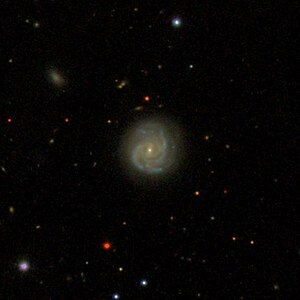NGC 3009
| Galaxy NGC 3009 |
|
|---|---|

|
|
| SDSS recording | |
| AladinLite | |
| Constellation | Big Bear |
|
Position equinox : J2000.0 , epoch : J2000.0 |
|
| Right ascension | 09 h 50 m 11.1 s |
| declination | + 44 ° 17 ′ 42 ″ |
| Appearance | |
| Morphological type | Sc / HII |
| Brightness (visual) | 12.7 mag |
| Brightness (B-band) | 13.4 mag |
| Angular expansion | 0.8 ′ × 0.7 ′ |
| Position angle | 161 ° |
| Surface brightness | 11.9 mag / arcmin² |
| Physical data | |
| Redshift | 0.015564 +/- 0.000037 |
| Radial velocity | 4666 +/- 11 km / s |
|
Stroke distance v rad / H 0 |
(209 ± 15) x 10 6 ly (64.1 ± 4.5) Mpc |
| diameter | 50,000 ly |
| history | |
| discovery | John Herschel |
| Discovery date | March 17, 1828 |
| Catalog names | |
| NGC 3009 • UGC 5264 • PGC 28303 • CGCG 239-033 • MCG + 07-20-062 • IRAS F09470 + 4431 • KUG 0947 + 445A • 2MASX J09501107 + 4417419 • USGC U261 NED06 | |
NGC 3009 is a spiral galaxy with extensive star formation regions of the Hubble type Sc in the constellation Great Bear in the northern sky . It is estimated to be 209 million light years from the Milky Way and about 50,000 light years in diameter.
In the same area of the sky are u. a. the galaxies NGC 3005 , NGC 3006 , NGC 3008 , NGC 3010 .
The object was discovered by John Herschel on March 17, 1828 . All the sources consulted identify NGC 3009 for the galaxy PGC 28303, with the exception of Professor Seligman, who claims it is the galaxy PGC 28330 (NGC 3010).
